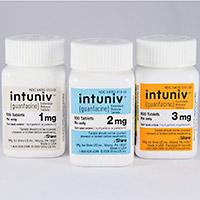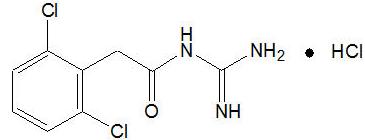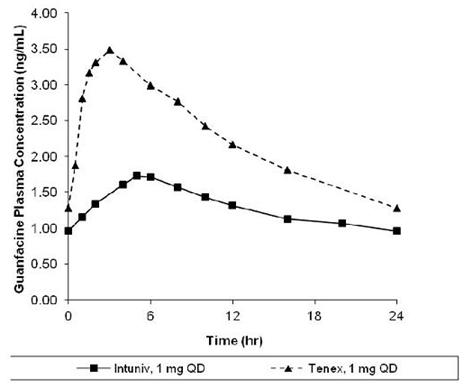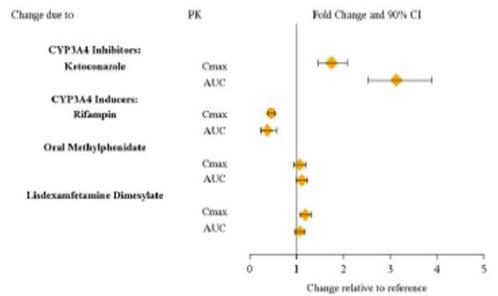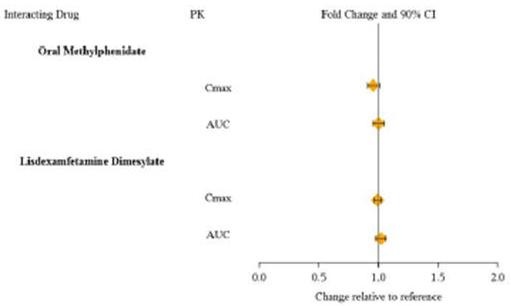|
英文药名:INTUNIV(guanfacine Extended-Release Tablets) 中文药名:胍法辛缓释片 生产厂家:希雷美国公司
INTUNIV® is a central alpha2A-adrenergic receptor agonist indicated for the treatment of Attention Deficit Hyperactivity Disorder (ADHD) as monotherapy and as adjunctive therapy to stimulant medications (1,14). DOSAGE AND ADMINISTRATION Recommended dose: 1 mg to 7 mg (0.05-0.12 mg/kg target weight based dose range) once daily in the morning or evening based on clinical response and tolerability (2.2). Begin at a dose of 1 mg once daily and adjust in increments of no more than 1 mg/week (2.2). Do not crush, chew or break tablets before swallowing (2.1). Do not administer with high-fat meals, because of increased exposure (2.1). Do not substitute for immediate-release guanfacine tablets on a mg-per-mg basis, because of differing pharmacokinetic profiles (2.3). If switching from immediate-release guanfacine, discontinue that treatment and titrate with INTUNIV® as directed (2.3). When discontinuing, taper the dose in decrements of no more than 1 mg every 3 to 7 days to avoid rebound hypertension (2.5). DOSAGE FORMS AND STRENGTHS Extended-release tablets: 1 mg, 2 mg, 3 mg and 4 mg (3) CONTRAINDICATIONS History of hypersensitivity to INTUNIV®, its inactive ingredients, or other products containing guanfacine (4). WARNINGS AND PRECAUTIONS Hypotension, bradycardia, syncope: Titrate slowly and monitor vital signs frequently in patients at risk for hypotension, heart block, bradycardia, syncope, cardiovascular disease, vascular disease, cerebrovascular disease or chronic renal failure. Measure heart rate and blood pressure prior to initiation of therapy, following dose increases, and periodically while on therapy. Avoid concomitant use of drugs with additive effects unless clinically indicated. Advise patients to avoid becoming dehydrated or overheated (5.1). Sedation and somnolence: Occur commonly with INTUNIV®. Consider the potential for additive sedative effects with CNS depressant drugs. Caution patients against operating heavy equipment or driving until they know how they respond to INTUNIV® (5.2). Cardiac Conduction Abnormalities: May worsen sinus node dysfunction and atrioventricular (AV) block, especially in patients taking other sympatholytic drugs. Titrate slowly and monitor vital signs frequently (5.3). Blood Pressure and Heart Rate Increase upon Discontinuation: Hypertensive encephalopathy has been very rarely reported upon abrupt discontinuation. To minimize the risk of an increase in blood pressure upon discontinuation, the total daily dose of INTUNIV® should be tapered in decrements of no more than 1 mg every 3 to 7 days (5.4). ADVERSE REACTIONS Most common adverse reactions (≥5% and at least twice placebo rate) in fixed-dose monotherapy ADHD trials in children and adolescents (6 to 17 years): hypotension, somnolence, fatigue, nausea, and lethargy (6.1) Flexible dose-optimization ADHD trials in children (6 to 12 years) and adolescents (13 to 17 years): somnolence, hypotension, abdominal pain, insomnia, fatigue, dizziness, dry mouth, irritability, nausea, vomiting, and bradycardia (6.1). Adjunctive treatment to psychostimulant ADHD trial in children and adolescents (6 to 17 years): somnolence, fatigue, insomnia, dizziness, and abdominal pain (6.1). To report SUSPECTED ADVERSE REACTIONS, contact Shire US Inc. at 1-800-828-2088 or FDA at 1-800-FDA-1088 or www.fda.gov/medwatch. DRUG INTERACTIONS Strong CYP3A4 inhibitors increase guanfacine exposure. Decrease INTUNIV® to 50% of target dosage when coadministered with strong CYP3A4 inhibitors (2.7). Strong CYP3A4 inducers decrease guanfacine exposure. Based on patient response, consider titrating INTUNIV dosage up to double the target dosage over 1 to 2 weeks (2.7). See 17 for PATIENT COUNSELING INFORMATION and FDA-approved patient labeling. Revised: 3/2016 FULL PRESCRIBING INFORMATION: CONTENTS* 1 INDICATIONS AND USAGE INTUNIV® is indicated for the treatment of Attention Deficit Hyperactivity Disorder (ADHD) as monotherapy and as adjunctive therapy to stimulant medications [see Clinical Studies (14)]. 2 DOSAGE AND ADMINISTRATION 2.1 General Instruction for Use Swallow tablets whole. Do not crush, chew, or break tablets because this will increase the rate of guanfacine release. Do not administer with high fat meals, due to increased exposure. 2.2 Dose Selection Take INTUNIV orally once daily, either in the morning or evening, at approximately the same time each day. Begin at a dose of 1 mg/day, and adjust in increments of no more than 1 mg/week. In monotherapy clinical trials, there was dose- and exposure-related clinical improvement as well as risks for several clinically significant adverse reactions (hypotension, bradycardia, sedative events). To balance the exposure-related potential benefits and risks, the recommended target dose range depending on clinical response and tolerability for INTUNIV® is 0.05-0.12 mg/kg/day (total daily dose between 1-7 mg) (See Table 1). Table 1: Recommended Target Dose Range for Therapy with INTUNIV®
In the adjunctive trial which evaluated INTUNIV® treatment with psychostimulants, the majority of patients reached optimal doses in the 0.05-0.12 mg/kg/day range. Doses above 4 mg/day have not been studied in adjunctive trials. 2.3 Switching from Immediate-Release Guanfacine to INTUNIV® If switching from immediate-release guanfacine, discontinue that treatment, and titrate with INTUNIV® following above recommended schedule. Do not substitute for immediate-release guanfacine tablets on a milligram-per-milligram basis, because of differing pharmacokinetic profiles. INTUNIV® has significantly reduced Cmax (60% lower), bioavailability (43% lower), and a delayed Tmax (3 hours later) compared to those of the same dose of immediate-release guanfacine [see Clinical Pharmacology (12.3)]. 2.4 Maintenance Treatment Pharmacological treatment of ADHD may be needed for extended periods. Healthcare providers should periodically re-evaluate the long-term use of INTUNIV®, and adjust weight-based dosage as needed. The majority of children and adolescents reach optimal doses in the 0.05-0.12 mg/kg/day range. Doses above 4 mg/day have not been evaluated in children (ages 6-12 years) and above 7 mg/day have not been evaluated in adolescents (ages 13-17 years) [see Clinical Studies (14)]. 2.5 Discontinuation of Treatment Following discontinuation of INTUNIV®, patients may experience increases in blood pressure and heart rate [see Warnings and Precautions (5.4) and Adverse Reactions (6)]. Patients/caregivers should be instructed not to discontinue INTUNIV® without consulting their health care provider. Monitor blood pressure and pulse when reducing the dose or discontinuing the drug. Taper the daily dose in decrements of no more than 1 mg every 3 to 7 days to avoid rebound hypertension. 2.6 Missed Doses When reinitiating patients to the previous maintenance dose after two or more missed consecutive doses, consider titration based on patient tolerability. 2.7 Dosage Adjustment with Concomitant Use of Strong CYP3A4 Inhibitors or Inducers Dosage adjustments for INTUNIV® are recommended with concomitant use of strong CYP3A4 inhibitors (e.g., ketoconazole), or CYP3A4 inducers (e.g., carbamazepine) (Table 2) [see Drug Interactions (7)]. Table 2: INTUNIV® Dosage Adjustments for Patients Taking Concomitant CYP3A4 Inhibitors or Inducers
1 mg, 2 mg, 3 mg and 4 mg extended-release tablets 4 CONTRAINDICATIONS INTUNIV is contraindicated in patients with a history of a hypersensitivity reaction to INTUNIV or its inactive ingredients, or other products containing guanfacine. Rash and pruritus have been reported. 5 WARNINGS AND PRECAUTIONS 5.1 Hypotension, Bradycardia, and Syncope Treatment with INTUNIV® can cause dose-dependent decreases in blood pressure and heart rate. Decreases were less pronounced over time of treatment. Orthostatic hypotension and syncope have been reported [see Adverse Reactions (6.1)]. Measure heart rate and blood pressure prior to initiation of therapy, following dose increases, and periodically while on therapy. Titrate INTUNIV slowly in patients with a history of hypotension, and those with underlying conditions that may be worsened by hypotension and bradycardia; e.g., heart block, bradycardia, cardiovascular disease, vascular disease, cerebrovascular disease, or chronic renal failure. In patients who have a history of syncope or may have a condition that predisposes them to syncope, such as hypotension, orthostatic hypotension, bradycardia, or dehydration, advise patients to avoid becoming dehydrated or overheated. Monitor blood pressure and heart rate, and adjust dosages accordingly in patients treated concomitantly with antihypertensives or other drugs that can reduce blood pressure or heart rate or increase the risk of syncope. 5.2 Sedation and Somnolence Somnolence and sedation were commonly reported adverse reactions in clinical studies [see Adverse Reactions (6.1)]. Before using INTUNIV® with other centrally active depressants, consider the potential for additive sedative effects. Caution patients against operating heavy equipment or driving until they know how they respond to treatment with INTUNIV®. Advise patients to avoid use with alcohol. 5.3 Cardiac Conduction Abnormalities The sympatholytic action of INTUNIV® may worsen sinus node dysfunction and atrioventricular (AV) block, especially in patients taking other sympatholytic drugs. Titrate INTUNIV slowly and monitor vital signs frequently in patients with cardiac conduction abnormalities or patients concomitantly treated with other sympatholytic drugs. 5.4 Blood Pressure and Heart Rate Increase upon Discontinuation Blood pressure and pulse may increase following discontinuation of INTUNIV®. In postmarketing experience, hypertensive encephalopathy has been very rarely reported upon abrupt discontinuation of INTUNIV® [see Adverse Reactions (6.2)]. To minimize the risk of an increase in blood pressure upon discontinuation, the total daily dose of INTUNIV® should be tapered in decrements of no more than 1 mg every 3 to 7 days [see Dosage and Administration (2.5)]. Blood pressure and pulse should be monitored when reducing the dose or discontinuing INTUNIV®. 6 ADVERSE REACTIONS The following serious adverse reactions are described elsewhere in the labeling: Hypotension, bradycardia, and syncope [see Warnings and Precautions (5.1)] Sedation and somnolence [see Warnings and Precautions (5.2)] Cardiac conduction abnormalities [see Warnings and Precautions (5.3)] Blood Pressure and Heart Rate Increase upon Discontinuation [see Warnings and Precautions (5.4)] 6.1 Clinical Trials Experience Because clinical trials are conducted under widely varying conditions, adverse reaction rates observed in the clinical trials of a drug cannot be directly compared to rates in the clinical trials of another drug and may not reflect the rates observed in practice. The data described below reflect clinical trial exposure to INTUNIV® in 2,825 patients. This includes 2,330 patients from completed studies in children and adolescents, ages 6 to 17 years and 495 patients in completed studies in adult healthy volunteers. The mean duration of exposure of 446 patients that previously participated in two 2-year, open-label long-term studies was approximately 10 months. Fixed Dose Trials Table 3: Percentage of Patients Experiencing Most Common (≥5% and at least twice the rate for placebo) Adverse Reactions in Fixed Dose Studies 1 and 2
The somnolence term includes somnolence, sedation, and hypersomnia. The hypotension term includes hypotension, diastolic hypotension, orthostatic hypotension, blood pressure decreased, blood pressure diastolic decreased, blood pressure systolic decreased). Table 4: Adverse Reactions Leading to Discontinuation (≥2% for all doses of INTUNIV and >rate than in placebo) in Fixed Dose Studies 1 and 2
The lowest dose of 1 mg used in Study 2 was not randomized to patients weighing more than 50 kg. The somnolence term includes somnolence, sedation, and hypersomnia. Table 5: Other Common Adverse Reactions (≥2% for all doses of INTUNIV and >rate than in placebo) in Fixed Dose Studies 1 and 2
The nightmare term includes abnormal dreams, nightmare, and sleep terror. The enuresis term includes enuresis, nocturia, and urinary incontinence. The affect lability term includes affect lability and mood swings. Monotherapy Flexible Dose Trials Table 6: Percentage of Patients Experiencing Most Common (≥5% and at least twice the rate for placebo) Adverse Reactions in the Monotherapy Flexible Dose Study 4
The hypotension term includes hypotension, diastolic hypotension, orthostatic hypotension, blood pressure decreased, blood pressure diastolic decreased, blood pressure systolic decreased). The enuresis term includes enuresis, nocturia, and urinary incontinence. Table 7: Adverse Reactions Leading to Discontinuation (≥2% for all doses of INTUNIV and >rate than in placebo) in Monotherapy Flexible Dose Study 4
The somnolence term includes somnolence, sedation, and hypersomnia. Table 8: Other Common Adverse Reactions (≥2% for all doses of INTUNIV and >rate than in placebo) in the Monotherapy Flexible Dose Study 4
Table 9: Percentage of Patients Experiencing Most Common (≥ 5% and at least twice the rate for placebo) Adverse Reactions in the Monotherapy Flexible Dose Study 5
The hypotension term includes hypotension, diastolic hypotension, orthostatic hypotension, blood pressure decreased, blood pressure diastolic decreased, blood pressure systolic decreased). The bradycardia term includes bradycardia and sinus bradycardia. There were no specific adverse reactions ≥2% in any treatment group that led to discontinuation in the monotherapy flexible dose study (Study 5). Table 10: Other Common Adverse Reactions (≥2% for all doses of INTUNIV and >rate than in placebo) in the Monotherapy Flexible Dose Study 5
The abdominal pain term includes abdominal pain, abdominal pain lower, abdominal pain upper, and abdominal tenderness. The anxiety term includes anxiety and nervousness. The rash term includes rash, rash generalized, and rash papular. The abdominal/stomach discomfort term includes abdominal discomfort, epigastric discomfort, and stomach discomfort. Adjunctive Trial Table 11: Percentage of Patients Experiencing Most Common (≥5% and at least twice the rate for placebo) Adverse Reactions in the Short-Term Adjunctive Study 3
The abdominal pain term includes abdominal pain, abdominal pain lower, abdominal pain upper, and abdominal tenderness. There were no specific adverse reactions ≥2% in any treatment group that led to discontinuation in the short-term adjunctive study (Study 3). Table 12: Other Common Adverse Reactions (≥2% for all doses of INTUNIV and >rate than in placebo) in the Short-Term Adjunctive Study 3
The affect lability term includes affect lability and mood swings. The bradycardia term includes bradycardia and sinus bradycardia. The rash term includes rash, rash generalized, and rash papular. The nightmare term includes abnormal dreams, nightmare, and sleep terror. The tachycardia term includes tachycardia and sinus tachycardia. Effects on Blood Pressure and Heart Rate In the monotherapy pediatric, short-term, controlled trials (Studies 1 and 2), the maximum mean changes from baseline in seated systolic blood pressure, diastolic blood pressure, and pulse were −5.4 mmHg, −3.4 mmHg, and −5.5 bpm, respectively, for all doses combined (generally one week after reaching target doses). For the respective fixed doses 1 mg/day, 2 mg/day, 3 mg/day or 4 mg/day the maximum mean changes in seated systolic blood pressure were -4.3 mmHg, -5.5 mmHg, -5.4 mmHg and -8.2 mmHg. For these respective fixed doses the maximum mean changes in seated diastolic blood pressure were -3.4 mmHg, -3.3 mmHg, -4.4 mmHg and -5.4 mmHg. For these respective fixed doses the maximum mean changes in seated pulse were -4.8 bpm, -3.1 bpm, -6.5 bpm and -8.6 bpm. Decreases in blood pressure and heart rate were usually modest and asymptomatic; however, hypotension and bradycardia can occur. Hypotension was reported as an adverse reaction for 7% of the INTUNIV® group and 3% of the placebo group. This includes orthostatic hypotension, which was reported for 1% of the INTUNIV® group and none in the placebo group. These findings were generally similar in the monotherapy flexible dose trials (Studies 4 and 5). In the adjunctive trial, hypotension (3%) and bradycardia (2%) were observed in patients treated with INTUNIV® as compared to none in the placebo group. In long-term, open-label studies, (mean exposure of approximately 10 months), maximum decreases in systolic and diastolic blood pressure occurred in the first month of therapy. Decreases were less pronounced over time. Syncope occurred in 1% of pediatric patients in the clinical program. The majority of these cases occurred in the long-term, open-label studies. Discontinuation of Treatment Blood pressure and pulse may increase following discontinuation of INTUNIV®. In postmarketing experience, hypertensive encephalopathy has been very rarely reported upon abrupt discontinuation of INTUNIV® [see Adverse Reactions (6.2)]. In a maintenance of efficacy study in children and adolescents [see Clinical Studies (14)], increases in mean systolic and diastolic blood pressure, of approximately 3 mmHg and 1 mmHg respectively, above original baseline were observed upon discontinuation of INTUNIV®. The increases in blood pressure were observed in some individuals at the end of the follow up period which ranged between 3 and 26 weeks post final dose. Mean increases in pulse of approximately 1.5 bpm were observed at approximately 2 weeks after the last dose of INTUNIV® and then decreased to baseline 4 weeks later. In this study, the increases in blood pressure and pulse were not considered serious or associated with adverse events. However, individuals may have larger increases than reflected by the mean changes. Effects on Height, Weight, and Body Mass Index (BMI) Patients taking INTUNIV® demonstrated similar growth compared to normative data. Patients taking INTUNIV® had a mean increase in weight of 0.5 kg compared to those receiving placebo over a comparable treatment period. Patients receiving INTUNIV® for at least 12 months in open-label studies gained an average of 8 kg in weight and 8 cm (3 in) in height. The height, weight, and BMI percentile remained stable in patients at 12 months in the long-term studies compared to when they began receiving INTUNIV®. Other Adverse Reactions Observed in Clinical Studies Table 13 includes additional adverse reactions observed in short-term, placebo-controlled and long-term, open-label clinical studies not included elsewhere in section 6.1, listed by organ system. Table 13: Other adverse reactions observed in clinical studies
The following adverse reactions have been identified during post-approval use of guanfacine. Because these reactions are reported voluntarily from a population of uncertain size, it is not always possible to reliably estimate their frequency or establish a causal relationship to drug exposure. Less frequent, possibly guanfacine-related events observed in the post-marketing study and/or reported spontaneously, not included in section 6.1, include: General: edema, malaise, tremor Cardiovascular: palpitations, tachycardia, hypertensive encephalopathy Central Nervous System: paresthesias, vertigo Eye Disorders: blurred vision Musculo-Skeletal System: arthralgia, leg cramps, leg pain, myalgia Psychiatric: confusion, hallucinations Reproductive System, Male: impotence Respiratory System: dyspnea Skin and Appendages: alopecia, dermatitis, exfoliative dermatitis, pruritus, rash Special Senses: alterations in taste 7 DRUG INTERACTIONS Table 14 contains clinically important drug interactions with INTUNIV® [see Clinical Pharmacology (12.3)]. Table 14: Clinically Important Drug Interactions: Effect of other Drugs on INTUNIV®
8.1 Pregnancy Pregnancy Category B Risk Summary There are no adequate and well-controlled studies of INTUNIV in pregnant women. No fetal harm was observed in rats and rabbits with administration of guanfacine at 4 and 2.7 times, respectively, the maximum recommended human dose. Because animal studies are not always predictive of human response, this drug should be used during pregnancy only if clearly needed. Animal data Reproduction studies conducted in rats have shown that guanfacine crosses the placenta. However, administration of guanfacine to rats and rabbits at 4 and 2.7 times, respectively, the maximum recommended human dose of 0.12 mg/kg/day on a mg/m2 basis resulted in no evidence of harm to the fetus. Higher doses (13.5 times the maximum recommended human dose in both rabbits and rats) were associated with reduced fetal survival and maternal toxicity. 8.3 Nursing Mothers It is not known whether guanfacine is excreted in human milk; however, guanfacine is excreted in rat milk. Because many drugs are excreted in human milk, caution should be exercised when INTUNIV® is administered to a nursing woman. Observe human milk-fed infants for sedation and somnolence. 8.4 Pediatric Use Safety and efficacy of INTUNIV® in pediatric patients less than 6 years of age have not been established. The efficacy of INTUNIV® was studied for the treatment of ADHD in five controlled monotherapy clinical trials (up to 15 weeks in duration), one randomized withdrawal study and one controlled adjunctive trial with psychostimulants (8 weeks in duration) in children and adolescents ages 6-17 who met DSM-IV® criteria for ADHD [see Adverse Reactions (6) and Clinical Studies (14)]. Animal Data In studies in juvenile rats, guanfacine alone produced a slight delay in sexual maturation in males and females at 2 to 3 times the maximum recommended human dose (MRHD). Guanfacine in combination with methylphenidate produced a slight delay in sexual maturation and decreased growth as measured by a decrease in bone length in males at a dose of guanfacine comparable to the MRHD and a dose of methylphenidate approximately 4 times the MRHD. In a study where juvenile rats were treated with guanfacine alone from 7 to 59 days of age, development was delayed as indicated by a slight delay in sexual maturation and decreased body weight gain in males at 2 mg/kg/day and in females at 3 mg/kg/day. The No Adverse Effect Level (NOAEL) for delayed sexual maturation was 1 mg/kg/day, which is equivalent to the MRHD of 4 mg/day, on a mg/m2 basis. The effects on fertility were not evaluated in this study. In a study where juvenile rats were treated with guanfacine in combination with methylphenidate from 7 to 59 days of age, a decrease in ulna bone length and a slight delay in sexual maturation were observed in males given 1 mg/kg/day of guanfacine in combination with 50 mg/kg/day of methylphenidate. The NOAELs for these findings were 0.3 mg/kg of guanfacine in combination with 16 mg/kg/day of methylphenidate, which are equivalent to 0.3 and 1.4 times the MRHD of 4 mg/day and 54 mg/day for guanfacine and methylphenidate, respectively, on a mg/m2 basis. These findings were not observed with guanfacine alone at 1 mg/kg/day or methylphenidate alone at 50 mg/kg/day. 8.5 Geriatric Use The safety and efficacy of INTUNIV® in geriatric patients have not been established. 8.6 Renal Impairment It may be necessary to reduce the dosage in patients with significant impairment of renal function [see Clinical Pharmacology (12.3)]. 8.7 Hepatic Impairment It may be necessary to reduce the dosage in patients with significant impairment of hepatic function [see Clinical Pharmacology (12.3)]. 9 DRUG ABUSE AND DEPENDENCE 9.1 Controlled Substance INTUNIV® is not a controlled substance and has no known potential for abuse or dependence. 10 OVERDOSAGE Symptoms Postmarketing reports of guanfacine overdosage indicate that hypotension, drowsiness, lethargy, and bradycardia have been observed following overdose. Initial hypertension may develop early and may be followed by hypotension. Similar symptoms have been described in voluntary reports to the American Association of Poison Control Center's National Poison Data System. Miosis of the pupils may be noted on examination. No fatal overdoses of guanfacine have been reported in published literature. Treatment Consult a Certified Poison Control Center by calling 1-800-222-1222 for up-to-date guidance and advice. Management of INTUNIV® overdose should include monitoring for and the treatment of initial hypertension, if that occurs, as well as hypotension, bradycardia, lethargy and respiratory depression. Children and adolescents who develop lethargy should be observed for the development of more serious toxicity including coma, bradycardia and hypotension for up to 24 hours, due to the possibility of delayed onset hypotension. 11 DESCRIPTION INTUNIV® is a once-daily, extended-release formulation of guanfacine hydrochloride (HCl) in a matrix tablet formulation for oral administration only. The chemical designation is N-amidino-2-(2,6-dichlorophenyl) acetamide monohydrochloride. The molecular formula is C9H9Cl2 N3O∙HCl corresponding to a molecular weight of 282.55. The chemical structure is:
Figure 1: Comparison of Pharmacokinetics: INTUNIV® vs. Immediate-release guanfacine in Adults
Difference (drug minus placebo) in least-squares mean change from baseline. Doses statistically significantly superior to placebo. The lowest dose of 1 mg used in Study 2 was not randomized to patients weighing more than 50 kg. Study 3: Flexible-dose INTUNIV® as Adjunctive Therapy to Psychostimulants Study 3 (313 study) was a double-blind, randomized, placebo-controlled, dose-optimization study, in which efficacy of once daily optimized dosing (morning or evening) with INTUNIV® (1 mg, 2 mg, 3 mg and 4 mg), when co-administered with psychostimulants, was evaluated for 8 weeks, in children and adolescents aged 6-17 years with a diagnosis of ADHD, with a sub-optimal response to stimulants (n=455). Patients were started at the 1 mg INTUNIV® dose level and were titrated weekly over a 5-week dose-optimization period to an optimal INTUNIV® dose not to exceed 4 mg/day based on tolerability and clinical response. The dose was then maintained for a 3-week dose maintenance period before entry to 1 week of dose tapering. Patients took INTUNIV® either in the morning or the evening while maintaining their current dose of psychostimulant treatment given each morning. Allowable psychostimulants in the study were ADDERALL XR®, VYVANSE®, CONCERTA®, FOCALIN XR®, RITALIN LA®, METADATE CD® or FDA-approved generic equivalents. Symptoms of ADHD were evaluated on a weekly basis by clinicians using the ADHD Rating Scale (ADHD-RS-IV), which includes both hyperactive/impulsive and inattentive subscales. The primary efficacy outcome was the change from baseline to endpoint in ADHD-RS-IV total scores. Endpoint was defined as the last post-randomization treatment week prior to dose tapering for which a valid score was obtained (up to Week 8). Mean reductions in ADHD-RS-IV total scores at endpoint were statistically significantly greater for INTUNIV® given in combination with a psychostimulant compared to placebo given with a psychostimulant for Study 3, for both morning and evening INTUNIV® dosing (see Table 17). Nearly two-thirds (64.2%) of patients reached optimal doses in the 0.05-0.12 mg/kg/day range. Studies 4, 5 and 6: Flexible-dose INTUNIV® Monotherapy Study 4 (314 study) was a double-blind, randomized, placebo-controlled, dose-optimization study, in which efficacy of once daily dosing (morning or evening) with INTUNIV® (1 mg, 2 mg, 3 mg, and 4 mg) was evaluated for 8 weeks in children aged 6-12 years (n=340). Signs and symptoms of ADHD were evaluated on a once weekly basis using the clinician administered and scored ADHD Rating Scale (ADHD-RS-IV), which includes both hyperactive/impulsive and inattentive subscales. The primary efficacy outcome was the change from baseline score at endpoint on the ADHD-RS-IV total scores. Endpoint was defined as the last post-randomization treatment week for which a valid score was obtained prior to dose tapering (up to Week 8). Mean reductions in ADHD-RS-IV total scores at endpoint were statistically significantly greater for INTUNIV® compared to placebo in both AM and PM dosing groups of INTUNIV® (see Table 17). Study 5 (312 study) was a 15-week, double-blind, randomized, placebo-controlled, dose-optimization study conducted in adolescents aged 13-17 years (n=314) to evaluate the efficacy and safety of INTUNIV® (1-7 mg/day; optimized dose range of 0.05-0.12 mg/kg/day) in the treatment of ADHD as measured by the ADHD Rating Scale-IV (ADHD-RS-IV). Patients receiving INTUNIV® showed statistically significantly greater improvement on the ADHD-RS-IV total score compared with patients receiving placebo (see Table 17). Study 6 (316 study) was a 12-week (for children aged 6-12) or 15-week (for adolescents aged 13-17), randomized, double-blind, parallel-group, placebo- and active-reference, dose-optimization study conducted in pediatric patients (children and adolescents aged 6-17 years old inclusive) (n=337) to assess the efficacy and safety of once-daily dosing (children: 1-4 mg/day, adolescents: 1-7 mg/day; optimized dose range of 0.05 to 0.12 mg/kg/day) in the treatment of ADHD. INTUNIV® was statistically superior to placebo on symptoms of ADHD in patients 6-17 years as measured by change from baseline in ADHD-RS-IV total scores (see Table 17). Table 17: Flexible-Dose studies
Treatment was given in combination with a psychostimulant. Doses statistically significantly superior to placebo. Study 7: Long-Term Maintenance of INTUNIV® Efficacy Study 7 (315 study) was a double-blind, placebo-controlled, randomized withdrawal trial in pediatric patients aged 6 to 17 years with DSM-IV-TR diagnosis of ADHD. The study consisted of an open-label phase, including a 7-week dose optimization period to titrate patients to an optimal dose (maximum 4 mg/day for children and 7 mg/day for adolescents; optimized dose range: 0.05 to 0.12 mg/kg/day) and a 6-week dose maintenance period. There were 526 patients included in the open-label phase. Among those, 315 patients who met response criteria in the open-label phase were then randomized (1:1, INTUNIV:placebo) in a 26-week, double-blind, randomized withdrawal phase. The response criteria were defined by ≥30% reduction in ADHD-RS-IV total score and a Clinical Global Impression-Improvement (CGI-I) score of 1 or 2 during the open-label phase. A statistically significantly lower proportion of treatment failures occurred among INTUNIV patients compared to placebo at the end of the randomized withdrawal period (Figure 4). Treatment failure was defined as a ≥50% increase (worsening) in ADHD-RS-IV total score and a ≥2-point increase in Clinical Global Impression-Severity (CGI-S) score. Patients who met the treatment failure criteria on two consecutive visits or discontinued for any reason were classified as treatment failure. Figure 4. Kaplan-Meier Estimation of Proportion of Patients with Treatment Failure for Children and Adolescents Ages 6-17 (Study 7)
https://dailymed.nlm.nih.gov/dailymed/drugInfo.cfm?setid=B972AF81-3A37-40BE-9FE1-3DDF59852528 | ||||||||||||||||||||||||||||||||||||||||||||||||||||||||||||||||||||||||||||||||||||||||||||||||||||||||||||||||||||||||||||||||||||||||||||||||||||||||||||||||||||||||||||||||||||||||||||||||||||||||||||||||||||||||||||||||||||||||||||||||||||||||||||||||||||||||||||||||||||||||||||||||||||||||||||||||||||||||||||||||||||||||||||||||||||||||||||||||||||||||||||||||||||||||||||||||||||||||||||||||||||||||||||||||||||||||||||||||||||||||||||||||||||||||||||||||||||||||||||||||||||||||||||||||||||||||||||||||||||||||||||||||||||||||||||||||||||||||||||||||||||||||||||||||||||||||||||||||||||||||||||||||||||||||||||||||||||||||||||||||||||||||||||||||||||||||||||||||||||||||||||||||||||||||||||||||||||||||||||||||||||||||||||||||||||||||||||||||||||||||||||||||||||||||||||||||||||||||||||||||||||||||||||||||||||||||||||||


